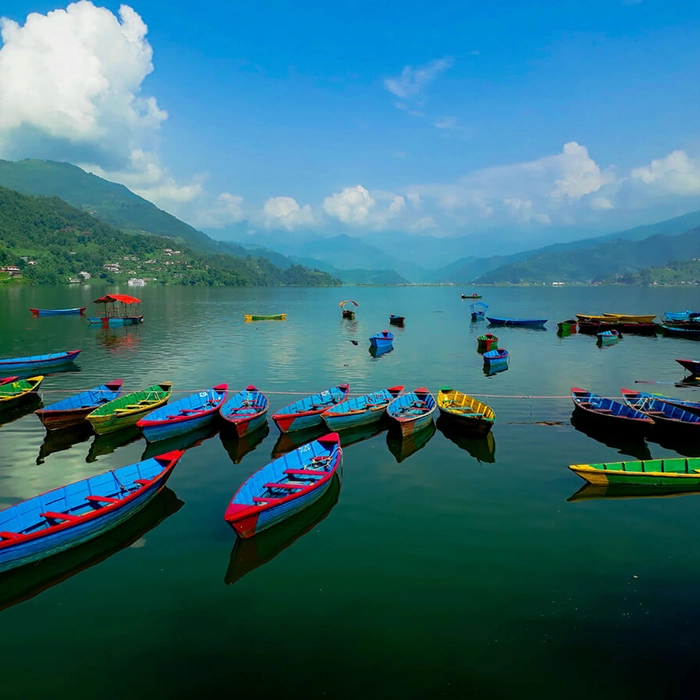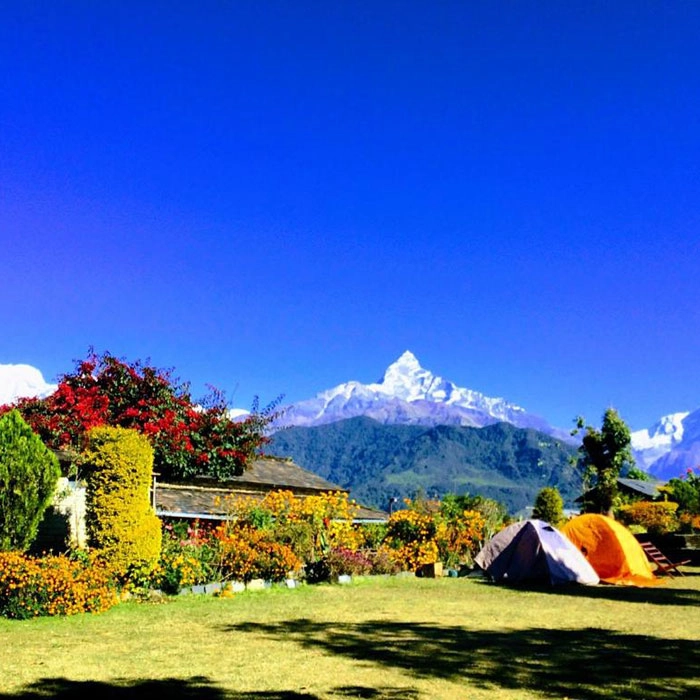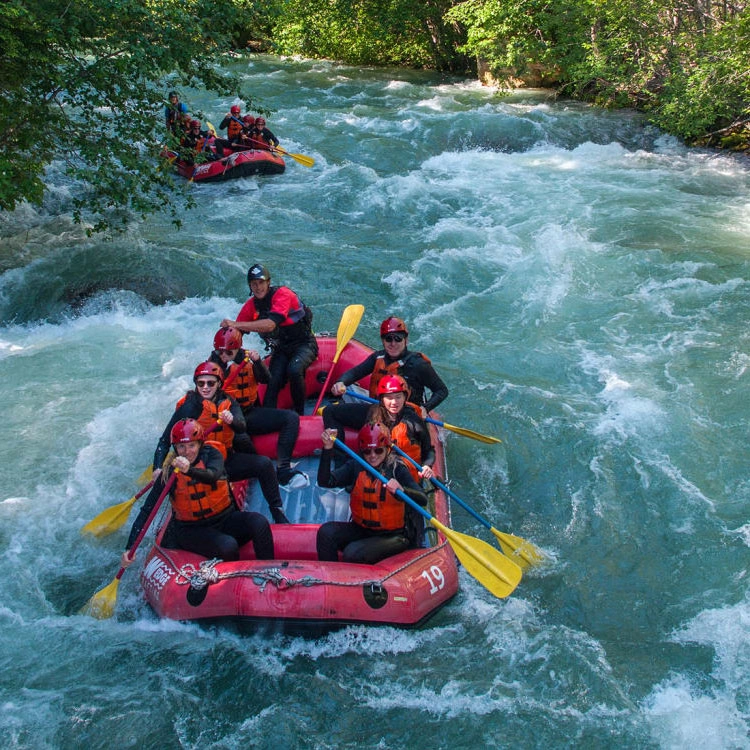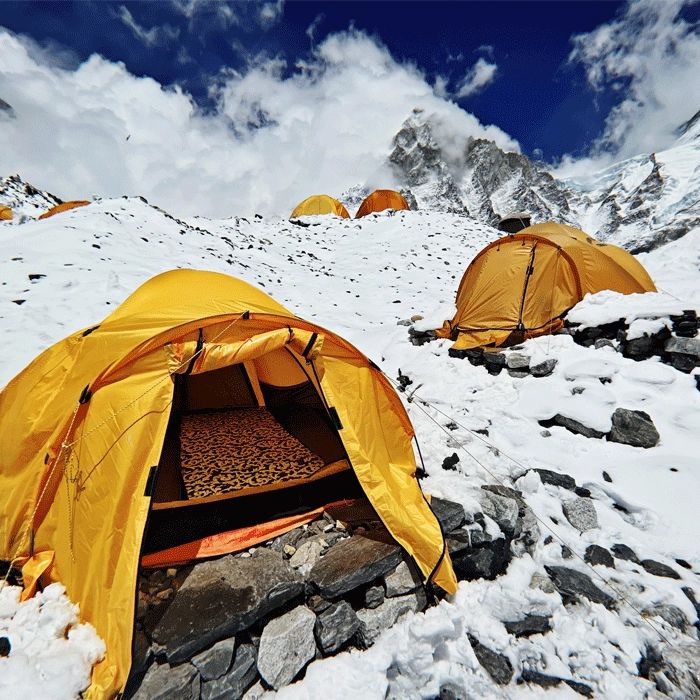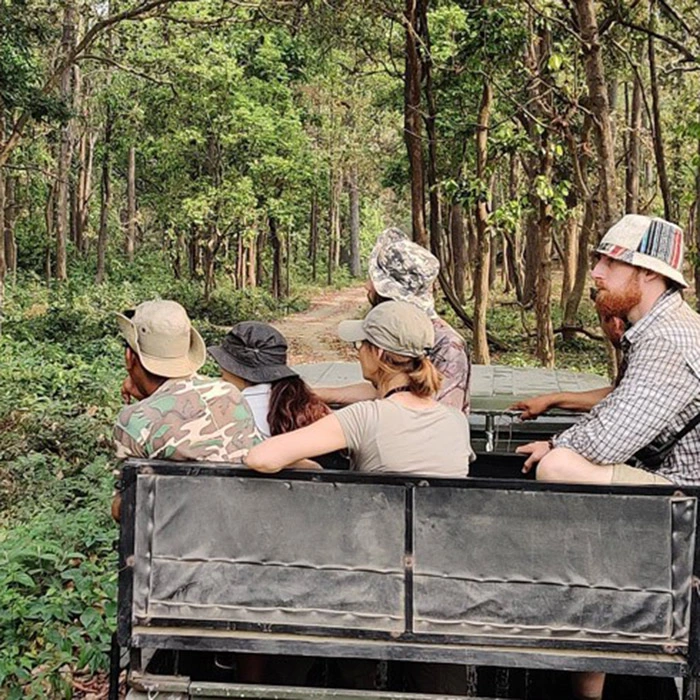UPPER MUSTANG TREK
US$3,240.00
/pp
-
18 Days
-
Mustang
-
Spring/Autumn
-
Trekking
-
4,280 Meters
-
Moderate
-
Car / Plane
-
02-16 People
-
JH#256
 Overviews
Overviews
Upper Mustang, famously known as Nepal’s ‘Last Forbidden Kingdom’ in the Mustang district, is a remote and culturally rich trekking destination, celebrated for its ancient Tibetan heritage, striking desert landscapes, and pristine Himalayan scenery. Nestled in the rain shadow of the Himalayas, this hidden region offers a fascinating blend of dramatic desert landscapes, Tibetan Buddhist culture, and centuries-old history. Unlike other trekking regions in Nepal, Upper Mustang remains largely untouched by modernization, giving travelers a rare glimpse into a world where ancient traditions and natural beauty thrive in harmony. Start your adventure with a spectacular Pokhara to Jomsom flight, where you can enjoy panoramic aerial views of the Annapurna and Dhaulagiri mountain ranges, along with the dramatic depths of the Kali Gandaki Gorge, setting the perfect tone for your Upper Mustang trekking journey. From Jomsom (2,743 m), trekkers follow the winding paths of the Kali Gandaki River, passing through traditional Tibetan villages such as Kagbeni (2,804 m), where stone-paved alleys and monasteries welcome visitors into the cultural heart of Mustang. As you trek deeper into the region, the landscape transforms into a high-altitude desert, featuring colorful cliffs, eroded canyons, and surreal rock formations. Every step of the Upper Mustang trek unveils striking vistas of the region’s arid beauty, with dramatic cliffs, rugged canyons, and desert-like landscapes that stand in sharp contrast to the verdant valleys found elsewhere in the Himalayas. The trek also leads to the walled city of Lo Manthang, the former royal capital, where ancient monasteries, palaces, and narrow alleys tell stories of Mustang’s royal heritage and spiritual life. Another captivating aspect of Upper Mustang is its cliffside Chhoser caves, which served as meditation retreats and ancient dwellings. These sacred caves, along with remote villages scattered throughout the region, provide travelers with an authentic experience of Tibetan Buddhist traditions, where centuries-old rituals, prayer flags, and local festivals remain alive. High mountain passes like Marang La Pass (also called Chongo La, 4,280 m) reward trekkers with panoramic views of hidden valleys, snow-capped peaks, and endless horizons, making the journey as visually stunning as it is spiritually enriching. Each element of the trek—from desert landscapes to cultural encounters—creates a unique adventure that combines natural beauty, history, and spirituality in one of the world’s most extraordinary Himalayan regions. Whether you are a seasoned trekker, a cultural explorer, or a photography enthusiast, the Upper Mustang Trek offers a once-in-a-lifetime experience. Embark on this journey to the mystical Last Forbidden Kingdom of Nepal and discover landscapes, traditions, and experiences that few travelers in the world will ever witness. Upper Mustang Trek DifficultyThe Upper Mustang Trek is considered a moderate to moderately challenging trek, thus making it suitable for trekkers with a reasonable level of fitness. While the trail does not involve extreme altitude or technical climbing, it does reach elevations of over 3,800 meters (12,500 ft) and includes long walking days of 5–7 hours on dry, rocky terrain and exposed, windy plateaus. The region’s arid climate and remote location can add to the challenge, but the well-established paths and gradual ascents make it accessible to most physically prepared travelers. With proper pacing and acclimatization, the Upper Mustang Trek is a rewarding adventure through one of Nepal’s most culturally rich and restricted regions. Upper Mustang Trek CostThe Upper Mustang Trek is a restricted-region trek, and its cost reflects the special permits and remote logistics required. The package generally includes essential services such as a licensed guide, restricted area permits, ACAP entry fees, accommodation in local lodges, meals during the trek, porter service, and all ground transportation. Solo trekkers receive full support, while groups benefit from tiered discounts, with prices decreasing as group size increases. Additionally, we offer special rates during off-peak trekking seasons. While the website lists standard global prices, we encourage you to contact us directly for private group bookings, as we can offer custom pricing tailored to your group size and travel dates. Our goal is to provide the best value with the highest standard of service for this unforgettable journey into Nepal’s hidden Himalayan kingdom.
 Itinerary (Plan)
Itinerary (Plan)
Arrive in Kathmandu (1,400 m / 4,593 feet), Nepal's vibrant capital, where you'll be warmly welcomed with marigold garlands. After transferring to your hotel, take time to relax and acclimate to the bustling city. Discover vibrant local markets, indulge in traditional Nepali dishes, and delve into Kathmandu's rich cultural tapestry. This initial day is perfect for easing into your journey, setting the stage for the exciting adventures ahead in Eastern Nepal. A representative from Jagadamba Holidays will ensure a smooth and pleasant arrival.
Optional Evening Activity:
If you wish, you can spend your evening experiencing the Pashupatinath Aarti, a captivating religious ceremony held at the Pashupatinath Temple. The Aarti usually begins around 6:00 PM and lasts for approximately an hour. This ceremony is a mesmerizing display of traditional music and rituals, providing a profound insight into Hindu spiritual practices. Please check the exact time for the Aarti on the day of your visit, as it may vary. This option is not included in the standard itinerary but offers a unique opportunity to immerse yourself in local culture.
Travel from Kathmandu to Pokhara (822 m) by a deluxe tourist bus, enjoying a scenic 6–7 hour overland journey covering approximately 200 km. The road passes through green hills, terraced farmlands, and traditional Nepalese villages, offering travelers a first-hand view of rural life. Along the way, you may notice small markets, roadside tea shops, and local farming activities that reflect authentic Nepalese culture. For travelers who prefer speed and a different perspective, a 30-minute flight from Kathmandu (1,400 m) to Pokhara is also available, providing breathtaking aerial vistas of the Himalayas, snow-capped peaks, and deep river valleys, creating an unforgettable beginning to your adventure in the heart of the Himalayas.
The overland route allows travelers to connect with the landscapes and communities of Nepal, making it a cultural and scenic experience. You’ll pass through winding mountain roads, waterfalls, rivers, and vibrant green valleys. On the other hand, the flight option offers a unique perspective with unobstructed views of the Annapurna (8,091 m) and Dhaulagiri (8,167 m) ranges, the Trishuli River, and the patchwork of forests and fields below. Both modes of travel provide a mix of comfort, adventure, and sightseeing, making the journey itself an integral part of your Nepal exploration.
Upon arrival in Pokhara, you will be transferred to your hotel for check-in and leisure time for relaxation. Pokhara, known as Nepal’s Lake City, is nestled beside the tranquil Phewa Lake, with the majestic Annapurna range forming a stunning backdrop. Spend your time exploring the serene lakeside, watching the sunrise over the mountains, or simply unwinding before embarking on your trekking adventure. This vibrant city is not only a hub for trekkers but also a place where natural beauty and local culture blend seamlessly, setting the perfect tone for your Upper Mustang Trek adventure or other Himalayan expeditions.
Start your Upper Mustang journey with a morning flight from Pokhara to Jomsom (2,743 m / 8,999 ft). A scenic flight from Pokhara to Jomsom provides panoramic views of the Annapurna (8,091 m) and Dhaulagiri (8,167 m) ranges, along with the deep Kali Gandaki Gorge. The aerial view showcases the stark contrasts of the Himalayan landscapes, from snow-capped peaks to terraced farmlands and winding rivers. Upon arriving in Jomsom, begin your trek to Kagbeni, a picturesque village situated at the confluence of the Kali Gandaki and Mustang rivers, where tradition and Himalayan culture thrive.
The trek covers about 10.4 kilometers, taking 3–4 hours with a gradual elevation gain of 320 meters and a descent of 220 meters. This moderate route allows smooth acclimatization while exploring the unique arid landscapes of Upper Mustang. The trail passes narrow valleys, rugged cliffs, and high desert terrain, offering stunning vistas of the Kali Gandaki Valley and surrounding Himalayan peaks. Along the way, discover Tibetan-style villages, stone-paved pathways, and ancient monasteries. You will also see terraced farmlands, riverbanks, and remote settlements, showcasing the resilient lifestyle of local mountain communities. The mix of scenic beauty, cultural experiences, and gradual altitude adjustment makes this trek an ideal introduction to the adventure, spirituality, and history of Upper Mustang.
Upon reaching Kagbeni (2,804 m / 9,199 ft), check in at a local guest house or lodge. Spend the evening wandering through the village with your trek guide or porter, uncovering its historical significance, traditional architecture, and rich cultural traditions. Learn about its historical significance, Tibetan traditions, and centuries-old architecture. Kagbeni is the gateway to Upper Mustang, where nature, culture, and tradition merge, setting the tone for your deeper journey into the mystical Last Forbidden Kingdom of Nepal.
Start your trek from Kagbeni after breakfast, heading through Chhusang (2,980 m) to Chele (3,050 m / 10,007 ft) on the Upper Mustang trekking route. This section of the trek immediately showcases the stark desert landscapes of Mustang, with towering cliffs, deep gorges, and ancient caves carved into the Himalayan terrain. Along the way, trekkers pass through traditional Tibetan-style villages, where stone houses are adorned with prayer flags and ancient inscriptions, offering a glimpse into the rich cultural heritage of Upper Mustang. Terraced farmlands, apple and apricot orchards, and small river crossings punctuate the rugged trail, giving insight into the resilient lifestyle of local mountain communities who have thrived in this high-altitude region for centuries.
The scenic trek spans approximately 14 kilometers, taking 6–7 hours, with a gradual ascent of 630 meters and a descent of 430 meters. The trail winds through narrow valleys, high desert terrain, and juniper forests, offering panoramic views of the Kali Gandaki Valley and majestic peaks including Nilgiri Peak (7,061 m) and Tilicho Peak (7,134 m). Along the route, you will encounter ancient monasteries, Buddhist chortens, and prayer wheels, allowing trekkers to experience the spiritual and religious traditions of Mustang firsthand. The combination of snow-capped Himalayan peaks, arid landscapes, and river valleys creates a dynamic visual experience unique to Nepal trekking.
As you trek, interact with local Tibetan communities, observing yak herding, traditional agriculture, and daily village life. These encounters offer cultural immersion into the ancient traditions, festivals, and customs of the Mustang region, enhancing the adventure with meaningful experiences beyond the natural scenery. The gradual ascent and moderate distance make this trek section ideal for acclimatization, while immersing travelers in the cultural, historical, and natural wonders of Upper Mustang.
Upon reaching Chele, check in at a local teahouse or lodge. Spend the evening exploring the village with your trek guide or porter, discovering ancient stone houses, monasteries, and traditional Tibetan courtyards. Learn about Mustang’s Tibetan heritage, centuries-old architecture, and spiritual traditions, while enjoying the peaceful ambiance and dramatic Himalayan surroundings. Chele serves as a perfect stop on the Upper Mustang trek, combining adventure, culture, and scenic beauty, and preparing trekkers for the next stage of their journey through the mystical landscapes of Nepal’s Last Forbidden Kingdom.
Start your trek from Chele after breakfast, heading via Chungsi Cave to Syangboche (3,800 m / 12,467 ft) on the Upper Mustang trekking route. This section of the trek features a challenging ascent through stark, arid landscapes, including rugged cliffs, deep gorges, and high-altitude deserts. Along the trail, trekkers pass through traditional Tibetan-style villages, where stone houses are decorated with prayer flags and ancient inscriptions, reflecting the rich spiritual and cultural heritage of Upper Mustang. Enroute, you will encounter Chungsi Cave, an important religious site with ancient murals, meditation areas, and sacred shrines, offering insight into the local spiritual traditions.
The scenic trek covers approximately 14 kilometers, taking 7–8 hours, with an ascent of 1,290 meters and a descent of 590 meters. The trail winds through narrow canyons, rocky passes, and high desert terrain, providing breathtaking views of the Annapurna (8,091 m) and Dhaulagiri (8,167 m) ranges. The dramatic transformation of the landscape from lush valleys to barren Himalayan deserts highlights the unique beauty of Mustang. Along the route, ancient monasteries, Buddhist chortens, and prayer wheels give trekkers a deeper understanding of the region’s religious and cultural traditions.
As you trek, interact with local Tibetan communities, witnessing yak herding, traditional agriculture, and daily village life. These cultural encounters enrich your journey, revealing centuries-old customs, festivals, and lifestyles adapted to the harsh high-altitude environment. The combination of challenging terrain, panoramic Himalayan views, and immersive cultural experiences makes this trek section both rewarding and memorable.
Upon reaching Syangboche, check in at a local teahouse or lodge. Spend the evening exploring the village with your trek guide or porter, discovering charming stone houses, monasteries, and Tibetan courtyards. Absorb the tranquil atmosphere and panoramic vistas of surrounding peaks, while learning about the spiritual and historical heritage of Upper Mustang. Syangboche serves as an ideal stop, blending adventure, culture, and scenic splendor, and preparing trekkers for the next stage of the mystical journey through Nepal’s Last Forbidden Kingdom.
Start your trek from Syangboche after breakfast, ascending over the Nyi La Pass to reach Ghami (3,520 m) on the Upper Mustang trekking route. This section immediately presents the challenges of high-altitude trekking, with rugged trails, steep ascents, and dramatic landscapes that define Mustang’s remote beauty. Along the way, trekkers pass through narrow valleys, rocky ridges, and high desert terrain, with panoramic views of the Nilgiri and Annapurna ranges. The trail also passes traditional Tibetan-style villages, where stone houses, prayer flags, and ancient monasteries reflect the rich cultural heritage of Mustang.
The trek journey spans approximately 13.4 kilometers and typically takes 6–7 hours, with an ascent of 460 meters and a descent of 670 meters. Along the way, you will experience breathtaking landscapes of Upper Mustang as you cross the Nyi La Pass (3,932 m).The high-altitude pass offers breathtaking views over arid valleys, cliffs, and rugged mountain peaks, providing a memorable highlight of the Upper Mustang adventure. Trekkers experience the stark beauty of this remote Himalayan region, with open landscapes, dramatic rock formations, and distant snow-capped peaks.
Descending from the pass, the trail winds through rocky terrain and approaches Ghami, one of Mustang’s largest and most culturally significant villages. Here, narrow alleys, terraced fields, and traditional stone houses illustrate the resilient lifestyle of local communities who have adapted to the harsh environment. The combination of high-altitude trekking, panoramic scenery, and cultural immersion makes this section of the trek particularly rewarding.
Upon reaching Ghami, check in at a local teahouse. Spend the evening exploring the village with your trek guide or porter, discovering traditional architecture, Tibetan heritage, and centuries-old customs. Ghami provides a peaceful and authentic Himalayan experience, offering rest and preparation for the next stage of your journey through the mystical landscapes and rich culture of Upper Mustang, Nepal.
Start your trek from Ghami after breakfast, tracing the trail through the colorful village of Dhakmar (3,820 m) before heading to Tsarang (3,560 m / 11,680 ft) along the Upper Mustang trekking route. This segment reveals Mustang’s otherworldly landscapes, with red sandstone cliffs, unusual rock formations, and rugged trails that create a truly scenic adventure. Trekkers experience a blend of physical challenges and cultural discovery, with ascents, descents, and expansive views of the surrounding Himalayas.
The trek covers approximately 10.7 kilometers and usually takes 6 to 7 hours to complete. During this stage, trekkers face a 490-meter climb and a 470-meter descent, reaching Dhakmar, the highest point of the route and a must-see highlight of the Himalayan journey. Dhakmar is renowned for its striking red cliffs and Tibetan-style architecture, offering a rare combination of geological marvels and cultural richness. Along the way, travelers encounter ancient monasteries, colorful prayer flags, and traditional villages, each reflecting the timeless traditions of the Upper Mustang region. This route perfectly blends the dramatic natural scenery with the cultural heritage of the local communities, creating an experience that is both visually breathtaking and spiritually inspiring.
Though physically demanding, this section of the trek is highly rewarding, with panoramic views of deep valleys, rugged cliffs, and distant snow-capped peaks. It’s a journey where stunning natural landscapes intersect with sacred landmarks, delivering an unforgettable Himalayan adventure that engages both the eyes and the soul.
Upon reaching Tsarang, settle into a local teahouse and explore the cultural heart of Upper Mustang. Featuring a historic monastery, expansive chortens, and traditional Mustang-style homes, Tsarang provides a vivid window into the region’s centuries-old heritage. This peaceful village offers rest, inspiration, and preparation for the next stage of your Himalayan expedition through this enchanting kingdom.
Start your trek from Tsarang (3,560 m) after breakfast, tracing the trail through the historic village of Ghar Gumba (4,280 m / 14,042 ft.) before reaching the ancient walled city of Lo Manthang (3,840 m / 12,598 ft.). This section of the Upper Mustang trekking route takes you through arid Himalayan landscapes, marked by striking red cliffs, vast plateaus, and unique rock formations. Trekkers will experience a blend of physical challenge and cultural immersion, combining ascents, descents, and panoramic views of the surrounding Nilgiri and Annapurna ranges.
The trek spans approximately 17 kilometers and usually takes 7 to 8 hours to complete, with an 740-meter ascent and a 510-meter descent. Along the way, Ghar Gumba Monastery, perched atop a ridge, offers breathtaking views of the Himalayan valleys and peaks. Known for its ancient murals, sacred scriptures, and rich Buddhist heritage, the monastery is a key cultural highlight of the region.
Continuing along the trail, trekkers cross the challenging Chogo La Pass (4,280 m), rewarded with sweeping vistas of the surrounding mountain ranges. As the path descends toward Lo Manthang, the landscape opens into a scenic valley dotted with scattered villages, chortens, and fluttering prayer flags.
Arriving at Lo Manthang, the medieval walled city reveals its royal palace, monasteries, and traditional Tibetan-style homes, offering a glimpse into the region’s rich cultural heritage. Explore the narrow alleys and absorb the tranquil yet vibrant local life, blending naturally with the surrounding dramatic Himalayan scenery.
End the day with an overnight stay at a local lodge, soaking in the unique beauty and historical charm of this remote Upper Mustang kingdom, preparing for the next leg of your Himalayan adventure.
Lo Manthang, the walled capital of the ancient Kingdom of Mustang, is a treasure trove of cultural and historical landmarks. Nestled in the remote Upper Mustang region, this town offers visitors a unique glimpse into a world where Tibetan-Buddhist culture thrives in its purest form. Here are the key monuments and landmarks you should explore during your visit to Lo Manthang. Please note that exploring these sites by Jeep involves an additional cost, which should be paid directly to the Jeep driver:
Jampa Lhakhang (Jampa Gompa or "God House"):
Jampa Lhakhang, also known as Jampa Gompa or "God House," is one of the oldest and most revered religious structures in Lo Manthang, dating back to the 15th century. This gompa is renowned for its immense clay statues of deities and exquisite wall paintings, which illustrate the region's rich artistic and spiritual heritage. The intricate murals, depicting various Buddhist figures, are a testament to the skilled craftsmanship of the era. The gompa serves as a significant place of worship and is a vital part of the cultural and religious fabric of Lo Manthang, drawing pilgrims and visitors alike.
Thubchen Gompa:
Located near the Royal Palace, Thubchen Gompa is a striking red monastery that plays a central role in the religious life of Lo Manthang. This large, historic gompa features a vast assembly hall, where local ceremonies and religious events are held. The gompa's interior is adorned with beautifully preserved frescoes that depict scenes from Buddhist texts and teachings, offering a glimpse into the spiritual world of Mustang. Thubchen Gompa, with its rich history and cultural significance, stands as a testament to the enduring legacy of Tibetan Buddhism in the region.
Chodey Gompa:
Chodey Gompa is the main monastery of Lo Manthang, serving as the spiritual heart of the community. Closely associated with the royal family, this gompa is a focal point for religious events and daily worship. The monastery is home to a community of monks who continue the traditions of Tibetan Buddhism, offering prayers and performing rituals that have been passed down through generations. Chodey Gompa's serene atmosphere and its role as a spiritual center make it an essential part of Lo Manthang's cultural heritage, reflecting the deep-rooted religious beliefs of the Mustang region.
The Royal Palace of Lo Manthang:
The Royal Palace of Lo Manthang, a four-story structure, was once the residence of the Mustang kings and remains a symbol of the region's historical significance. Although the royal family no longer holds power, the palace continues to be an important cultural site. Its thick stone walls, wooden balconies, and intricate carvings reflect the traditional architecture of the region. Visitors to the palace can explore its history and gain insights into the former kingdom of Lo, making it a must-visit landmark in Lo Manthang. The palace stands as a reminder of Mustang's unique identity within Nepal.
Tingkhar Village:
Tingkhar is a small village located northwest of Lo Manthang, offering an authentic glimpse into the traditional way of life in Mustang. The village is home to a small community that has preserved its customs and traditions for centuries. Tingkhar is also known for the ruins of an ancient fortress, which adds a sense of historical intrigue to the area. The village's serene environment and its connection to Mustang's past make it an interesting destination for those looking to explore beyond the main attractions of Lo Manthang. Tingkhar provides a peaceful retreat with a deep sense of history.
Chosar Caves:
The Chosar Caves, situated near Chosar village, are ancient man-made caves believed to be thousands of years old. Initially serving as meditation retreats for Buddhist monks, these caves were later utilized as residential spaces. Meticulously carved into the cliffs, they offer a profound insight into the region's ancient history and early way of life. Some of the caves are intricately decorated with murals and contain relics from the past, making them an important archaeological and cultural site. The Chosar Caves are a testament to the ingenuity and spiritual dedication of the early inhabitants of Mustang.
Niphu and Garphu Gompas:
Niphu and Garphu Gompas are two significant monasteries located in the Chosar area, each offering a unique perspective on the spiritual and cultural heritage of Lo Manthang. Niphu Gompa is built into the cliffs, providing a dramatic setting for religious activities, while Garphu Gompa is situated nearby, known for its stunning views and serene atmosphere. Both gompas are important pilgrimage sites and are revered for their historical and religious significance. The surrounding landscape, with its stark beauty, enhances the spiritual experience of visiting these monasteries, making them essential stops on any cultural tour of Lo Manthang.
Tashi Kabum:
Tashi Kabum is a sacred site located near Lo Manthang, known for its religious significance and spiritual allure. It is a small cave that houses a statue of Guru Rinpoche (Padmasambhava), a revered figure in Tibetan Buddhism. The cave's walls are adorned with ancient murals, and it is considered a place of meditation and pilgrimage. Tashi Kabum offers a quiet and contemplative atmosphere, making it a perfect spot for reflection and spiritual practice. The site is a hidden gem in the Mustang region, attracting those who seek a deeper connection with the area's religious traditions.
Tibet Border Exploration:
A day trip from Lo Manthang to the Tibet border offers a unique opportunity to explore the remote and rugged terrain that connects Mustang to Tibet. This journey, often undertaken by jeep or horseback, provides stunning views of the high-altitude landscapes and a sense of the ancient trade routes that once linked these regions. The exploration near the border allows visitors to experience the cultural and geographical transition between Nepal and Tibet, making it a memorable adventure for those interested in the history and heritage of the Mustang region.
After exploring Lo Manthang, relish a peaceful overnight stay at a local lodge, savoring the tranquil beauty and rich historical ambiance of this remote Himalayan kingdom.
Start your trek from Lo Manthang after a hearty breakfast, the ancient walled capital of Upper Mustang, and continue towards the peaceful village of Yara Gaon (3,600 m / 11,811 ft.) via the scenic Dhi La Pass (3,950 m). Today’s journey crosses the picturesque Dhi La Pass (3,950 m / 12,959 ft.), offering a perfect blend of adventure, culture, and Himalayan scenery. The morning starts with gentle climbs along the outer edges of Lo Manthang, where the city’s medieval walls, traditional Tibetan-style homes, and ancient monasteries provide a fascinating cultural backdrop. As you leave the walled city, the trail opens into arid plateaus, rugged cliffs, and panoramic valleys, dotted with stone chortens and fluttering prayer flags that reflect the region’s spiritual heritage.
The trek spans approximately 15.3 kilometers and typically takes 6 to 7 hours, with a moderate to challenging route featuring 570 meters of ascent and 770 meters of descent. The trail begins by meandering across arid ridges, stark desert-like terrain, and striking rock formations, providing endless opportunities for photography and breathtaking Himalayan panoramas. Along the way, trekkers encounter ancient caves, mani walls, and traditional Tibetan architecture, showcasing the rich Buddhist culture and heritage of Upper Mustang. Every twist and turn brings stunning views of the Nilgiri and Annapurna ranges, red cliffs, and expansive valleys below.
The trail gradually ascends out of Lo Manthang through barren highland terrain and windswept ridges adorned with colorful prayer flags. As you approach Dhi La Pass, the path steepens, rewarding trekkers with breathtaking panoramic views of the surrounding Himalayan peaks and the arid Upper Mustang valley.
Descending from the pass, the trail passes through remote valleys and rugged landscapes, dotted with ancient chortens, mani walls, and sandstone caves. Along the way, you will encounter isolated hamlets and traditional Tibetan settlements, where villagers continue farming, yak herding, and weaving—providing a glimpse into a lifestyle largely untouched by modernity.
The approach to Yara Gaon winds along narrow paths and rocky terrain, passing hidden gorges and sculpted cliffs. This section of the trek combines natural beauty and cultural heritage, immersing trekkers in the timeless charm of Upper Mustang.
Arriving in Yara Gaon (3,600 m / 11,811 ft.), you’ll be greeted by traditional stone houses, historic monasteries, and a tranquil ambiance, all set against dramatic cliffs and lush terraced fields. The village is also home to Luri Gompa, a centuries-old cave monastery adorned with exquisite Buddhist murals.
Spend the evening at a local teahouse in Yara Gaon, soaking in the tranquil Himalayan landscapes and preparing for the next leg of your Upper Mustang trekking adventure.
Start your trek journey from Yara Gaon after a hearty breakfast, making your way to Tangge (3,350 m / 10,991 ft.). This journey takes you along rugged mountain paths, past historic monasteries, ancient chortens, and traditional villages, offering a deep immersion into the cultural heritage of Upper Mustang. Along the way, trekkers can interact with local communities, observe their unique customs, and appreciate architectural styles that have been preserved for centuries, while witnessing spiritual practices distinctive to this remote Himalayan region.
The trek covers roughly 15 kilometers (9.4 miles) and usually takes 6 to 7 hours. Travelers will ascend 710 meters (2,329 ft.) and descend 960 meters (3,150 ft.), experiencing a moderately demanding route. The trail passes through terraced fields, deep valleys, and dramatic canyons, revealing the stunning landscapes of Upper Mustang while offering moments of calm and solitude amid nature.
Arriving in Tangge, trekkers find a peaceful village enriched by Tibetan culture. The locals sustain their age-old traditions through farming, livestock herding, and daily communal life, giving visitors a rare insight into the authentic Mustang lifestyle. The village’s narrow cobbled lanes, stone-built houses, and tranquil surroundings make it an ideal setting for rest, reflection, and cultural appreciation.
Overnight stays at a teahouse in Tangge allow trekkers to enjoy authentic hospitality, traditional local dishes, and preparation for the next stage of the Upper Mustang trek. This journey from Yara Gaon to Tangge combines breathtaking scenery, rich cultural encounters, and immersive adventure, creating a memorable exploration of both natural beauty and the enduring heritage of this Himalayan region.
Start your trek journey from Tangge after a hearty breakfast, heading towards Tetang (3,050 m / 10,007 ft.) via Paha through the Tenang Valley. This scenic Upper Mustang trek offers a perfect blend of breathtaking Himalayan landscapes, ancient monasteries, traditional villages, and rich cultural heritage, providing trekkers with an immersive Himalayan adventure. Along the trail, you will traverse rugged mountain paths, explore local settlements, and witness centuries-old spiritual practices unique to this remote region.
The trek journey spans approximately 24.7 kilometers and generally takes 9 to 10 hours to complete. During the journey, trekkers will ascend 1,280 meters and descend 1,510 meters, following a moderately challenging route that rewards adventurers with spectacular mountain vistas and authentic cultural encounters. The trail passes through diverse terrains, from barren hills to fertile valleys, providing an immersive experience of Upper Mustang’s unique environment.
Along the way, you will pass through Paha and Chhusang, encountering ancient monasteries, chortens, and mani walls that reflect the region’s rich spiritual and historical heritage. Paha, a charming village with whitewashed houses and terraced fields, offers stunning views of the surrounding valleys and a glimpse into traditional Mustang life. Chhusang, situated along the Kali Gandaki River, leads trekkers through narrow gorges, rugged cliffs, and ancient gompas, revealing the deep spiritual essence of Upper Mustang.
Your final destination, Tetang, is a serene Himalayan village known for its well-preserved traditional architecture and tranquil ambiance. The trek from Tangge to Tetang perfectly balances physical adventure with cultural immersion, offering spectacular views of Mustang’s rugged landscapes and meaningful interactions with local communities.
In Tetang, immerse yourself in the remote charm of Upper Mustang, surrounded by majestic peaks and ancient monasteries. Stay at a cozy teahouse or lodge, enjoy authentic local cuisine, and soak in the serene beauty of this Himalayan region, preparing for the next stage of your Upper Mustang adventure.
After a hearty breakfast, begin your trek from Tetang to Muktinath (3,760 m / 12,336 ft.) via the high-altitude Gyu La Pass (4,077 m / 13,376 ft.). This remarkable journey offers a perfect blend of challenging Himalayan trekking, breathtaking landscapes, and spiritual exploration, taking you through some of Upper Mustang’s most dramatic high-altitude terrains. Along the trail, trekkers experience a mix of rugged mountains, expansive valleys, and remote settlements, providing an immersive Himalayan adventure in one of Nepal’s most pristine regions.
The trek covers approximately 13 kilometers and generally takes 6 to 7 hours to complete. During the journey, trekkers will ascend 980 meters and descend 460 meters, navigating a moderately challenging high-altitude route. This trek rewards adventurers with spectacular panoramic views of the Himalayas, stark arid landscapes, and the unforgettable sense of solitude unique to Upper Mustang.
The trail winds through dramatic high-altitude landscapes, offering sweeping vistas of the Himalayan peaks and the rugged, barren terrain of Upper Mustang. As you ascend toward the Gyu La Pass, you are greeted with breathtaking panoramas of iconic mountains such as Nilgiri and Annapurna, creating a surreal backdrop that captures the stark beauty of the Tibetan plateau. The vast open spaces, rugged cliffs, and expansive valleys make every step a visual feast for nature lovers and adventure seekers alike.
As trekkers near Muktinath, a revered site for both Hindu and Buddhist pilgrims, they encounter the profound spiritual essence and cultural importance of this sacred Himalayan destination. Muktinath is home to ancient temples, sacred water spouts, and colorful prayer flags, offering a glimpse into centuries-old religious traditions and rituals. This cultural and spiritual landmark provides a unique opportunity to connect deeply with Nepal’s rich spiritual heritage while experiencing the tranquility of its majestic Himalayan setting.
The Tetang to Muktinath trek perfectly combines awe-inspiring natural beauty with profound cultural and spiritual encounters, making it a fitting highlight of your Upper Mustang adventure. Upon arrival, relax at a nearby lodge or guesthouse, soak in the serene atmosphere, and reflect on your journey through one of Nepal’s most remote and captivating regions, as you prepare for your onward travels or next stage of exploration.
After enjoying a nourishing breakfast at the lodge, set out on your trek from Muktinath (3,760 m / 12,336 ft) to Jomsom (2,743 m / 8,999 ft) via Jhong and Lupra, a route that beautifully blends spirituality with Himalayan adventure. The trail reveals a diverse tapestry of landscapes, from sweeping alpine meadows and terraced farmlands to rugged cliffs and arid canyon-like valleys. Traditional villages dot the journey, while the backdrop of towering peaks showcases the dramatic terrain of Upper Mustang.
The trek journey spans nearly 19.7 kilometers and typically takes 6 to 7 hours, making it a rewarding full-day adventure in the high Himalayas. Along the way, you gain about 570 meters in elevation before descending roughly 1,500 meters, tackling paths that shift between gentle slopes and steep downhill sections. The constantly changing terrain highlights the raw natural beauty and distinct geology of the Mustang region.
Before beginning the descent, take time to visit Muktinath, a sacred pilgrimage site cherished by both Hindus and Buddhists. Known for its ancient temples, natural springs, and serene spiritual atmosphere, Muktinath sets an inspiring tone for the day’s journey.
The trail also leads through Lupra Village, one of the few settlements in Mustang practicing the ancient Bon religion. Its traditional Tibetan-style homes and cultural richness are complemented by an old Bon gompa (monastery), where colorful prayer flags and rituals reflect centuries of spiritual tradition, offering trekkers a rare cultural encounter.
The day concludes in Jomsom, a vibrant town along the Kali Gandaki River and the main gateway to Mustang. Jomsom offers a mix of comfort and liveliness, with cozy guesthouses, bustling markets, and local eateries. Surrounded by dramatic peaks and sweeping river valleys, it’s the perfect place to rest, explore, and reflect on the journey.
This trek from Muktinath to Jomsom via Lupra is more than just a route—it is an enriching blend of natural wonders, cultural depth, and spiritual discovery, leaving every traveler with lasting memories of Upper Mustang’s unmatched charm.
Scenic Mountain Flight from Jomsom to Pokhara
Begin Day 13 with a breathtaking flight from Jomsom (2,743 m / 9,000 ft) to Pokhara (822 m / 2,697 ft), a highlight of any Nepal trekking itinerary. This short domestic flight offers spectacular aerial views of the Annapurna Himalayan range and the transition from the rugged Kali Gandaki Valley to the lush, tranquil Pokhara Valley—Nepal’s premier lakeside city and trekking hub.
Discover Pokhara’s Natural and Cultural Gems
Upon arrival, spend a leisurely day exploring Pokhara’s top attractions. Visit the serene Phewa Lake with its famous Barahi Temple, the panoramic World Peace Pagoda overlooking the valley, and the majestic Davis Falls. Don’t miss Gupteshwor Cave’s sacred interior or the dramatic Seti River Gorge. Whether you prefer a peaceful boat ride or browsing vibrant local markets and cafés, Pokhara offers an unforgettable cultural and natural experience.
Relax and Recharge in Nepal’s Lakeside Paradise
After days of trekking, enjoy a well-earned rest in Pokhara’s calm and scenic environment. Savor authentic Nepali cuisine at lakeside restaurants, reflect on your Annapurna trekking adventure, or simply unwind by the water’s edge. This leisure day perfectly balances relaxation and exploration, preparing you for your onward journey through Nepal.
Important Note:
In case the flight from Jomsom to Pokhara is canceled due to weather conditions, we will arrange an immediate transfer by 4WD jeep. The journey takes approximately 6 to 7 hours on a smooth road. Please note that with this option, there won’t be time to explore Pokhara city and its surroundings. If you wish to have more leisure time in Pokhara, you can opt to pay extra for a flight from Pokhara to Kathmandu the following day and enjoy a full day in the lakeside city.
After a rewarding trekking journey, today is dedicated to both relaxation and exploration in the charming city of Pokhara (822 m / 2,697 ft.). Begin your day with a peaceful visit to Phewa Lake, where you can enjoy the stunning reflections of the Annapurna range on the tranquil waters. Opt for a leisurely boat ride on the lake to reach Tal Barahi Temple, situated on an island and offering a serene escape.
For expansive views, visit the World Peace Pagoda, a Buddhist stupa perched on a hilltop that provides panoramic vistas of Pokhara Valley and the majestic Himalayas, including the Annapurna and Dhaulagiri ranges. Alternatively, take a short hike to Sarangkot for breathtaking sunrise or sunset views over the Himalayas and a sweeping perspective of the valley.
Explore the vibrant Lakeside area, known for its lively atmosphere, charming cafes, boutique shops, and diverse restaurants. This area is perfect for leisurely shopping, enjoying local and international cuisine, and soaking in the vibrant ambiance.
Enhance your exploration with visits to notable local attractions. Marvel at Devi’s Fall, where the Pardi Khola River plunges dramatically into a deep gorge. Nearby, explore Gupteshwor Cave, a sacred site featuring a significant Shiva lingam and fascinating underground passages. Visit Bindhyabasini Temple, dedicated to the goddess Bindhyabasini, offering spiritual insights and a picturesque setting. Witness the striking Seti Gorge, carved by the powerful Seti River, known for its impressive geological formations. Finally, a trip to Pumdikot provides additional panoramic views and insight into the region’s natural beauty.
This day is crafted for relaxation and comprehensive exploration, allowing you to fully appreciate the tranquility and diverse attractions of Pokhara, marking a perfect conclusion to your trek.
After a scenic morning flight from Pokhara to Kathmandu (1,400 m / 4,593 ft), enjoy a smooth airport transfer to your hotel. The short flight offers breathtaking views of the majestic Himalayas, providing a fitting conclusion to your mountain adventure. Upon arrival, a guide or a representative from Jagadamba Holidays will be there to greet you and escort you to your hotel.
Take some time to settle in and refresh at your hotel. The remainder of the day is yours to explore the vibrant and bustling district of Thamel. Known for its narrow, winding streets, Thamel is a lively hub filled with vibrant markets, cozy cafes, and a wide range of shops offering traditional Nepali crafts, souvenirs, and apparel. Whether you’re seeking unique local items or soaking in the energetic atmosphere, Thamel offers a glimpse into Kathmandu’s rich cultural life.
As you wander through Thamel’s vibrant streets, immerse yourself in its lively energy. You’ll encounter an array of local handicrafts, Tibetan art, and traditional souvenirs, perfect for capturing memories of your journey. The area is dotted with numerous restaurants offering both Nepali and international cuisines, ensuring something to suit every taste. Don’t miss the chance to savor authentic dishes like momos, dal bhat, and traditional Newari specialties. Thamel also boasts cozy cafes and bars, making it an ideal spot to unwind after a day of exploration.
If time permits, consider visiting nearby landmarks such as Swayambhunath Stupa (commonly known as the Monkey Temple) and Kathmandu Durbar Square. These iconic sites offer fascinating insights into Nepal’s rich history and cultural heritage. The Swayambhunath Stupa, perched atop a hill, provides stunning panoramic views of the Kathmandu Valley, while Kathmandu Durbar Square, a UNESCO World Heritage Site, showcases ancient temples, historic architecture, and vibrant street life. Whether you choose to explore these landmarks or simply immerse yourself in Thamel’s charm, this day blends relaxation, exploration, and cultural discovery, creating the perfect conclusion to your journey through Nepal.
Concluding Your Journey in Nepal
As your remarkable journey through the Himalayas comes to an end, take a moment to reflect on the awe-inspiring natural beauty, rich cultural heritage, and memorable experiences that have defined your time in Nepal. From the majestic mountain landscapes to the warm hospitality of the local communities, every moment has contributed to an unforgettable adventure.
Airport Transfer by Jagadamba Holidays
To ensure a smooth and timely departure, an official representative from Jagadamba Holidays will collect you from your hotel 3.5 hours prior to your scheduled flight departure. Our team is committed to providing a reliable and comfortable transfer service to Tribhuvan International Airport, allowing you to conclude your journey with peace of mind.
We sincerely appreciate your trust in Jagadamba Holidays and hope to have the pleasure of serving you again on your future journeys.
Quotation 2025
| Group Size (Pax) |
2 - 3 |
4 - 5 |
6 - 7 |
8 - 9 |
10 - 12 |
13 - 16 |
17 - 20 |
21 - 24 |
25 - 32 |
| Cost Per Person |
$2,916 |
$2,866 |
$2,816 |
$2,766 |
$2,716 |
$2,666 |
$2,616 |
$2,566 |
$2,516 |
 Cost Include
Cost Include
- All transfers within Nepal are included as per itinerary
- Any domestic flight of Nepal as per trekking itinerary
- Trekking accommodation (hotel, lodge and/or tent) as per itinerary
- Small shared room with shared bathroom during trek in Nepal
- In Kathmandu and/or Pokhara: Stay at ***Hotel with breakfast
- Luggage for porters during the trek (12.5 kg/person)
- 3 meals (Breakfast, Lunch and Dinner) during the trek
- Unlimited tea or coffee for breakfast during the trek
- An English speaking guide (trekking/tour) as per Itinerary
- Travel insurance for trekking staff (guides and porters)
- All expenses of trekking staff(s) during trekking
- Includes all conservation, national park, trekking, and climbing permits
- Sightseeing / Wildlife tours if included in the itinerary
- Farewell dinner in Kathmandu before returning home
 Cost Exclude
Cost Exclude
- Single room/single tent surcharge (on request)
- Round trip/one way international flight ticket to Nepal.
- Tourist visa for Nepal (30-50 $, depending on length of stay)
- Personal Insurance (covers: Trip/flight cancellation, helicopter rescue)
- Meals (lunch, dinner) at hotels in Kathmandu, Pokhara and other cities
- Drinks (soft, hot or mineral/boiled water) during the lodge trek
- Any personal trekking and/climbing equipment for trekking in Nepal
- Hotel expenses in case of early return from trekking for any reason
- Costs due to flight cancellations & extra porters/horses during the trek
- Additional costs incurred due to any reason beyond Jagdamba’s control
- More evidence about pandemics like COVID-19 if needed in the future.
- Personal expenses during the trek (phone, wifi, shower, charging etc.)
- Other costs and things that are not mentioned in the service inclusion
- Gratuity for trekking staff (recommended: 9€ /10$ per traveler per day)
|

























 Overviews
Overviews
 Trip Overview
Trip Overview
 Travel Itinerary
Travel Itinerary
 Cost Include
Cost Include
 Cost Exclude
Cost Exclude
 Fixed Departure
Fixed Departure
 Route Map
Route Map
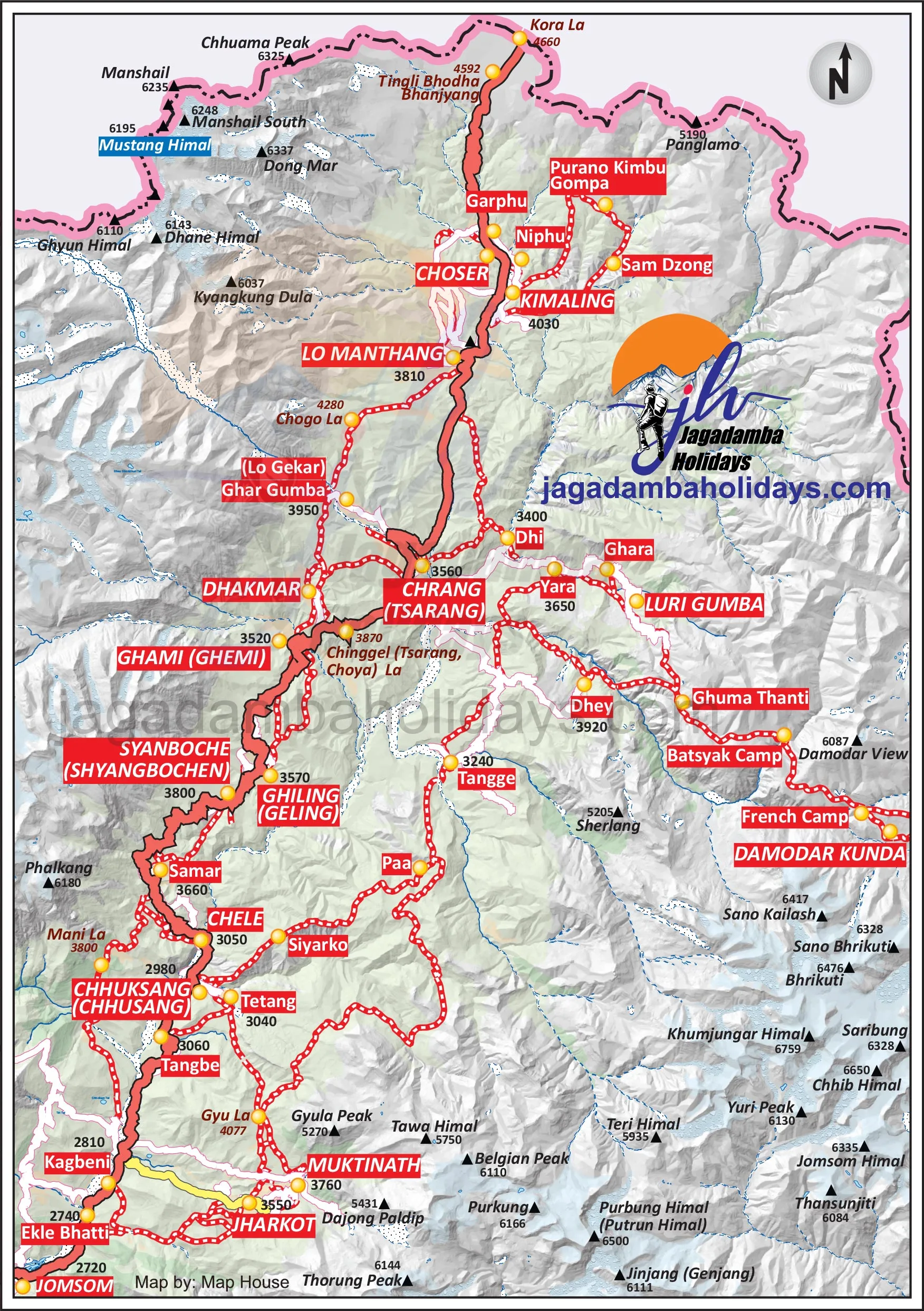
 Freqeuntly Asked Questions
Freqeuntly Asked Questions
 Reviews And Rating
Reviews And Rating
